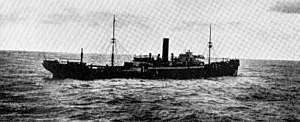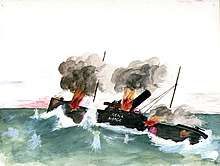SMS Leopard (1912)
 SMS Leopard | |
| History | |
|---|---|
| Name: | Leopard |
| Builder: | W Dobson, Newcastle upon Tyne |
| Launched: | 1912 |
| Commissioned: | 9 January 1917[1] |
| Fate: | Sunk 16 March 1917 |
| General characteristics | |
| Displacement: | 9,800 t (4652 GRT)[2] |
| Length: | 124.7 m |
| Beam: | 15.8 m |
| Draught: | 7.4 m |
| Propulsion: | 1×3 cyl III Exp |
| Speed: | 13 knot |
| Range: | 26,000 nm |
| Complement: | 319[3] |
| Armament: |
|
SMS Leopard was an auxiliary cruiser of the Imperial German Navy intended for use as a commerce raider. She was intercepted attempting to break out into the Atlantic and was sunk with all hands in a fierce gun battle with British warships.
Early career
Leopard was built as the British freighter Yarrowdale by W Dobson&co Newcastle in 1912. She was operated by R MacKill&Co of Glasgow.
On 11 December 1916 Yarrowdale was captured by the German commerce raider Möwe in the Atlantic. Möwe's captain, KK Graf zu Dohna-Schlodien was impressed by Yarrowdale's potential as a raider, and on 12 December dispatched her back to Germany with a prize crew, after loading her with the 400 prisoners he held on Möwe. After successfully running the British blockade Yarrowdale reached Germany and was taken in hand for conversion as an auxiliary cruiser.[5]
The conversion work was carried out at Kaiserliche Werft shipyard at Kiel. The ship was fitted with five 150 mm and four 88 mm guns and two torpedo tubes. On 9 January 1917 she was commissioned as the auxiliary cruiser Leopard, under the command of KK Hans v. Laffert.
Service history

In March 1917 Leopard set out on her first and only raiding voyage. For this she was disguised as the Norwegian freighter Rena, an unlucky choice as this was the same disguise adopted by the raider Greif on her unsuccessful attempt to break out the previous year.
On 7 March Leopard passed through the Little Belt, and by 16 March she was in the Norwegian Sea midway between Norway and Scotland. There she was intercepted by the Armed Boarding Vessel Dundee and the cruiser Achilles. Dundee sent a boarding party but was suspicious of the freighter, and manoeuvered throughout the confrontation to stay astern of the vessel, and out of gunshot, while Leopard surreptitiously tried to turn broadside on her, to bring the concealed guns into action.
When she could no longer maintain the subterfuge, Leopard attempted to fight, firing a torpedo at Dundee, but this was avoided, and Dundee opened fire, backed up by Achilles. After a fierce exchange of fire, Leopard was sunk with all hands.[6]
Aftermath
Leopard was the last attempt by the Germans to mount a commerce raiding expedition. After this failure they relied solely on the U-boat campaign, in which they had re-commenced unrestricted submarine warfare. Whilst Leopard was fighting her battle, her captor, Möwe, was returning to port, slipping through the British blockade.
A short time after the action a bottle was retrieved containing a message from her crew, and thrown overboard during the battle. It bore the time and place and read "in action with British cruiser. Fighting for the glory and honour of Germany. A last greeting to our relatives."[7]